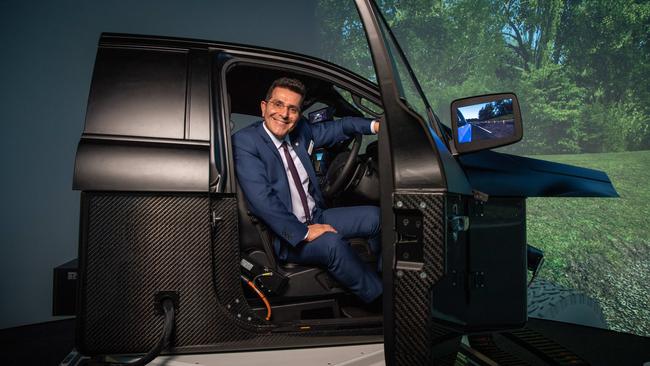How $9m simulator at Deakin could reduce carbon footprint of vehicle industry
A multimillion-dollar simulator at Waurn Ponds will allow car manufacturers to create new vehicles with less of a carbon footprint. Here’s how.

Geelong
Don't miss out on the headlines from Geelong. Followed categories will be added to My News.
A multimillion-dollar simulator at Waurn Ponds will allow car manufacturers to create new vehicles with a lighter carbon footprint.
A person can sit inside the $9m Genesis Simulator and have the experience of driving any type of car across all terrains and weather conditions.
The simulator, unveiled on Thursday at Deakin University’s Institute for Intelligent Systems Research and Innovation (IISRI), is among the most advanced mobility simulatorsin Australia, and the only one of its kind in a university.
Project director Professor Saeid Nahavandi said the 5m tall, 360-degree screen could be used for driver training as well as car testing.
He said manufacturers could use the simulator to test prototypes without the physical car needing to be built, in turn reducing cost and turnaround time.

“From a cost perspective, you don’t need access to a testing site, or the vehicle itself,” Prof Nahavandi said.
“You can simulate driving at night, on different terrain … you can program all of those inside the simulator, and let the person experience that safely.
“If you wanted to design a new vehicle – to design, prototype, build and then test it in different conditions can take a lot of time.
“You can do a large portion of that inside the simulator, before even building your first prototype.”
Prof Nahavandi said the simulator would reduce the time to create a vehicle and give manufacturers a “competitive edge”.
Ford Australia is one the partners attached to use the simulator in its research.
Vehicle dynamics simulator senior development engineer Matt Gerlach said the technology was likely to help offer an “even greater” driving experience and comfort to customers.
“We can run tests and find solutions more efficiently and in almost countless scenarios – ones that could otherwise take many people all over the world thousands of hours to do,” he said.
“We can be even more comprehensive and faster, which means our customers get an even better vehicle and potentially one that’s in market quicker because the testing time could be reduced.”
Prof Nahavandi said the carbon footprint of the simulator was much smaller than having a physical area to test vehicles in.
He said the technology – which can go from simulating a sedan one day to an 18-wheeler truck the next – was environmentally friendly because it doesn’t consume fuel.
The simulator, which was developed over 18 months and is justifies its price tag by the amount of freedom the user has in motion, received $5m in co-funding from the Victorian Higher Education State Investment Fund (VHESIF) which was started to boost the state’s productivity and economy in the Covid-19 pandemic recovery.
More Coverage
Originally published as How $9m simulator at Deakin could reduce carbon footprint of vehicle industry







